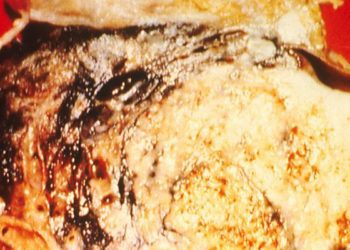2 Minute Medicine Rewind February 21, 2022
1. Primary care follow-up for asthma patients resulted in better adherence to inhaled corticosteroids.
2. Heavy alcohol use was significantly associated with poor participation in asthma follow-up visits.
Evidence Level Rating: 1 (Excellent)
Patients with poor asthma control often have reduced quality of life, increased risk of exacerbations and mortality, with corresponding increases in health care costs. A variety of factors may contribute to poor asthma control, including follow-up in primary care versus secondary care settings. This prospective cohort study assessed the occurrence of scheduled asthma contacts in a cohort of 257 patients with new-onset adult asthma at 12-year follow-up. Most patients (79%) were managed primarily by their primary care provider and 71% had ≥ 2 scheduled asthma contacts during 10-year follow-up. Within this cohort, self-reported daily inhaled corticosteroid (ICS) use was higher in patients with primary care follow-up (n=98, 88.3%), compared to secondary care (n=19, 63.3%), p<0.004. Patients with primary care follow-up also had better total adherence to ICS ≥ 80% during the 12-year period (p=0.026). The secondary objective was to identify the factors associated with non-participation to asthma follow-up visits, of which heavy alcohol use (≥ 14 drinks per week) was a significant predictor (p=0.027). Overall, these findings raise important implications for primary care providers scheduling regular follow-up visits for asthma patients.
1. Veterans who were taken by ambulance to Veterans Affairs hospitals had a 20.1% lower 30 day mortality rate compared with patients taken to non-veteran specialized facilities.
Evidence Level Rating: 2 (Good)
The public Veterans Affairs healthcare system in the US has previously been demonstrated to achieve similar performance outcomes as other hospitals. However, important underlying health differences between veterans and non-veterans have not been well evaluated to date. This retrospective cohort study tracked mortality in a cohort of 583 248 veterans aged 65 years and older who were enrolled in the Veterans Health Administration and initiated care using an ambulance ride for emergency treatment. Within this cohort, 231 611 (15.8%) of rides went to VA hospitals, and were similar to those who went to non-VA facilities but were more likely to be black, with higher rates of mental health and substance use disorders. Patients taken to VA hospitals had a 20.1% lower 30 day mortality rate (ARR 2.35, 95% CI 2.16 to 2.54), an advantage which was disproportionately large for Hispanic patients, black patients and patients with a relatively low mortality risk. While the generalizability of this study to other populations may be limited, these findings warrant further research into the mortality advantage of healthcare facilities for veterans.
Risk of Parkinson Disease and Secondary Parkinsonism in Myocardial Infarction Survivors
1. Myocardial infarction was associated with a 20% decreased risk of Parkinson’s disease and 28% decreased risk of secondary parkinsonism.
Evidence Level Rating: 2 (Good)
Parkinson’s disease risk is inversely associated with certain cardiovascular risk factors including smoking, hypercholesterolemia, hypertension and diabetes. The relationship of myocardial infarction (MI) to subsequent development of Parkinson’s disease has not been well established. This population-based matched cohort study evaluated 181 994 patients with a first-time MI diagnosis and 909 970 matched comparison cohort members. At 21 years of follow-up, the cumulative incidence of Parkinson’s disease and secondary parkinsonism were 0.9% and 0.1% respectively. The general population comparison cohort had a higher cumulative incidence of Parkinson disease and secondary parkinsonism, 1.25 (95% CI 1.20-1.29) and 0.14 (95% CI 0.12-0.16), than the MI cohort, 0.86 (95% CI 0.79-0.94) and 0.09 (95% CI 0.07-0.12). Finally, patients with MI had a moderately decreased risk of Parkinson disease (aHR, 0.80, 95% CI 0.73-0.87) and secondary parkinsonism (aHR, 0.72, 95% CI 0.54-0.94).
1. Platelet transfusions were associated with increased 28-day and 90-day all-cause mortality rates in ICU patients with sepsis and thrombocytopenia, in addition to fewer ICU and hospital-free days.
Evidence Level Rating: 2 (Good)
Platelet transfusions in intensive care units (ICUs) are common practice for sepsis patients with thrombocytopenia. Pre-transfusion platelet counts vary from 10,000 to 150,000/uL without clear evidence or guidelines for transfusion. This retrospective cohort study addressed the relationship between platelet transfusion and prognosis in a cohort of 15,726 patients who met Sepsis-3 criteria. Primary outcomes were 28- and 90-day all-cause mortalities, with RBC transfusion, ICU-free days, and hospital-free days comprising the list of secondary outcomes. Results indicated an increased risk of 28-day all-cause mortality [36.9 vs. 30.4%, OR 1.21; 95% CI, 1.01-1.46; p=0.039], increased risk of 90-day all-cause mortality (50.8 vs. 44.6%, OR, 1.13; 95% CI, 1.00-1.31; p=0.048), fewer mean 28-day ICU-free days (15.88 ± 8.97 vs. 18.64 ±8.33 days, p < 0.001), and fewer hospital-free days (10.29 ± 8.49 vs. 11.43 ± 8.85 days, p=0.017). High-quality evidence is needed to validate these findings.
1. Home-based aerobic exercise training improved fatigue, but had no benefit on aerobic capacity, thigh muscle mass, liver or spleen stiffness in patients with liver cirrhosis.
Evidence Level Rating: 1 (Excellent)
Exercise is recommended for many patients with chronic disease, including heart failure and lung disease. While exercise for patients with liver cirrhosis has demonstrated advantages, such as improved aerobic capacity, increased muscle mass and improved quality of life, providers have safety concerns for portal hypertension-related complications, and the practicality and sustainability of exercise required for positive outcomes are described as limiting factors. To date, few studies have assessed the efficacy and safety of home-based exercise training (HoBET) in cirrhotic patients. This randomized controlled study recruited 40 cirrhotic adults aged 18-65 with Child-Pugh scores ≤ 6, to blocks of HoBET or control group for 12 weeks, consisting of moderate intensity aerobic exercise. Exercise and nutritional counseling was provided to all patients throughout the study and patients were assessed for all outcome measures at baseline and end of the 12-week study period. The primary outcome was a change in aerobic capacity, while secondary outcomes included liver stiffness, thigh muscle thickness and quality of life. No significant difference in aerobic capacity was demonstrated between groups (p=0.36, 95% CI -15.5 to 41.7). Liver stiffness measurement was not significantly different between groups, nor was thigh muscle thickness. Fatigue domain of the quality of life index was significantly improved in the HoBET group compared to the control group (p=0.05, 95% CI 0.00 to 0.67).
Image: PD
©2022 2 Minute Medicine, Inc. All rights reserved. No works may be reproduced without expressed written consent from 2 Minute Medicine, Inc. Inquire about licensing here. No article should be construed as medical advice and is not intended as such by the authors or by 2 Minute Medicine, Inc.









